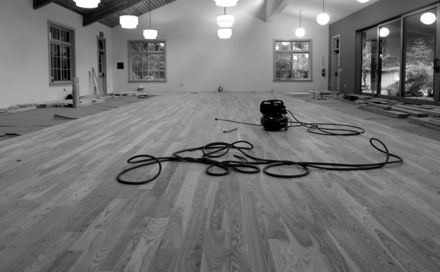Gurdjieff International Review
A Difficulty, Together...
Bill Dudley
The construction team has a task: Two thousand square feet of hardwood flooring to put down, with a major event approaching and only four working days available to accomplish the job.
Once the problem is presented and understood, a concerned silence develops. Some kind of quickening passes, wordlessly, among the team members, but without tension or haste. Most of this group has worked together for several years now, with many prior deadlines and pressures, and we know the implications, understand what is needed, what it will cost. Something begins to respond almost immediately. Physical movements become more direct and economical. Conversations are shortened and practical. All necessary tools and materials are on hand, having been foreseen and acquired in advance, so it is really a question of each man finding his place in the project. Simultaneously, each must come again to his own personal decision: do I want to work, to submit to the demand? In a surprisingly short time, this first unspoken agreement is reached and felt by all.
There’s no sentimentality. He who knows how to do a particular thing, must do it. The others follow. It’s that simple. And patently obvious that in relation to the aim there’s just no place for chest-pounding or hurt feelings or petty arguments; these things fall away of their own dead weight. The goal watches over us, mediating the inevitable difficulties between us, referring all disagreements back to itself. Always: what helps?
Where skills overlap, some trading-off of tasks goes on, but we don’t take turns like children on a see-saw. At the same time, new things are learned. Since this particular crew has done this work before, there are habits to be both remembered and overcome. We remain attentive to places where something can or must be done differently, maybe even more effectively. Adjustments are needed to a new material (this floor is ash and we’re used to maple), to new tools (flooring nail guns have changed since we last used them) and to new people, a couple of whom have never had this level of demand placed upon them before. We feel their attention on us, also without sentimentality. This, we are reminded, is how things are actually transmitted and received—under pressure, under the look of a common aim. Many moments arise, some collective, some private, where we clearly feel this “vertical aspect” of the task.
The myriad obstacles inherent in all construction processes appear, are attended to, and recede as the wood is put down and the floor begins to appear. It’s not easy, but since no one expected easy, we find it’s really not that hard, either. We work in teams of three, with one man choosing the next piece from the bundles, giving much attention to length, grain pattern and color, while another double-checks for quality, places the piece and taps it into position for the third member, whose only job is to nail it down, at just the right moment, with the exact amount of force required. The nailing is especially tricky, as the nail guns are not completely automatic but are driven by a mallet that has to land very precisely, with enough force to drive the nail but not split out the tongue or groove. It happens very fast, with an attention both concentrated and inclusive of the others. One team works toward the north wall, one towards the south and progress is measured in total feet of width completed per day, with 37 feet to be done. The first day, seven feet. By the third day, almost fifteen, as everyone gradually finds their place and the work becomes more of a dance. There are moments when someone stops and simply listens. We can all hear it, feel the flow and rhythm of work. We begin to sense each other, intimately, on the level of our inner states. This sensitivity arises from the intensity, but without trying or manipulating anything directly. There’s nothing to say, but when eyes meet, there are smiles. We all know something special is happening. Why would anyone want to control or interfere with it?
The job is accomplished with half a day to spare. Later, the floor finisher will come in and sand and varnish, but this team’s work is done. We take a few moments after clearing the tools to simply look and take in the impression, both of the room and ourselves. With an average age of well over 50, we know we may never be together like this again, and this brings another silence, now with more depth, more feeling. Our final task is to cover the entire floor in carpets, to protect it during the event. Instead of irony—that all our work will be invisible beneath the rugs—there is the quiet, neutral taste of freedom and of faith. We have worked together, and that is enough.

For many years Bill Dudley has participated in and led construction projects at the San Francisco Gurdjieff Foundation. Photo by John Oliver.
| Copyright © 2012 Gurdjieff Electronic Publishing Featured: Spring 2012 Issue, Vol. XI (1) Revision: April 1, 2012 |